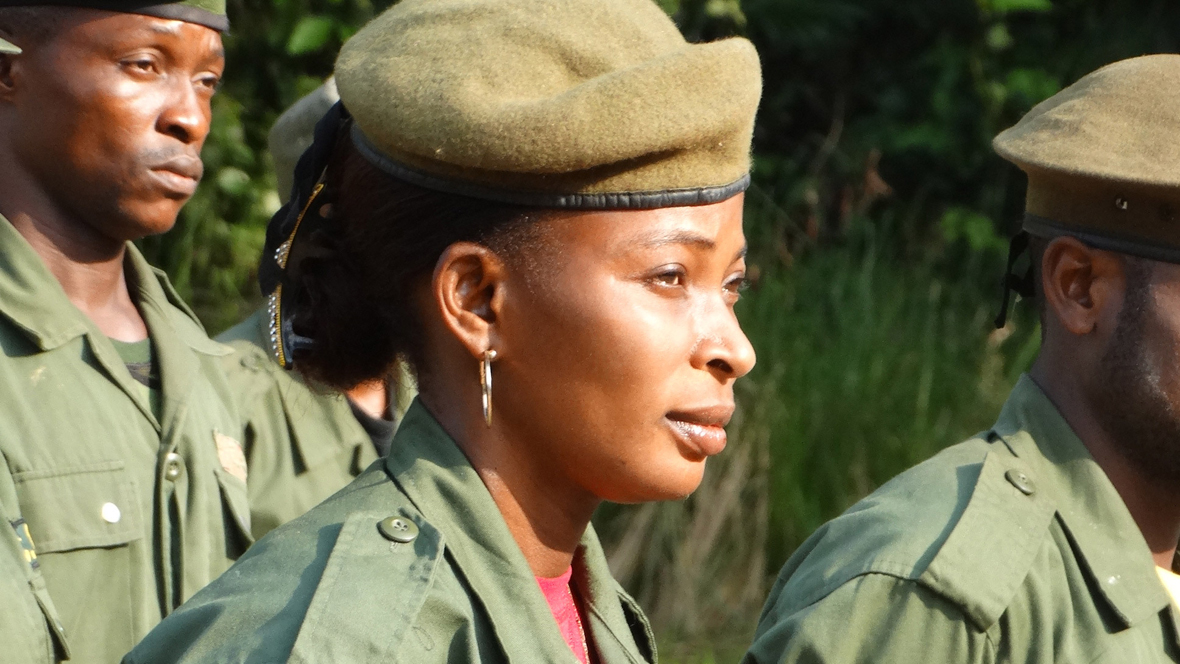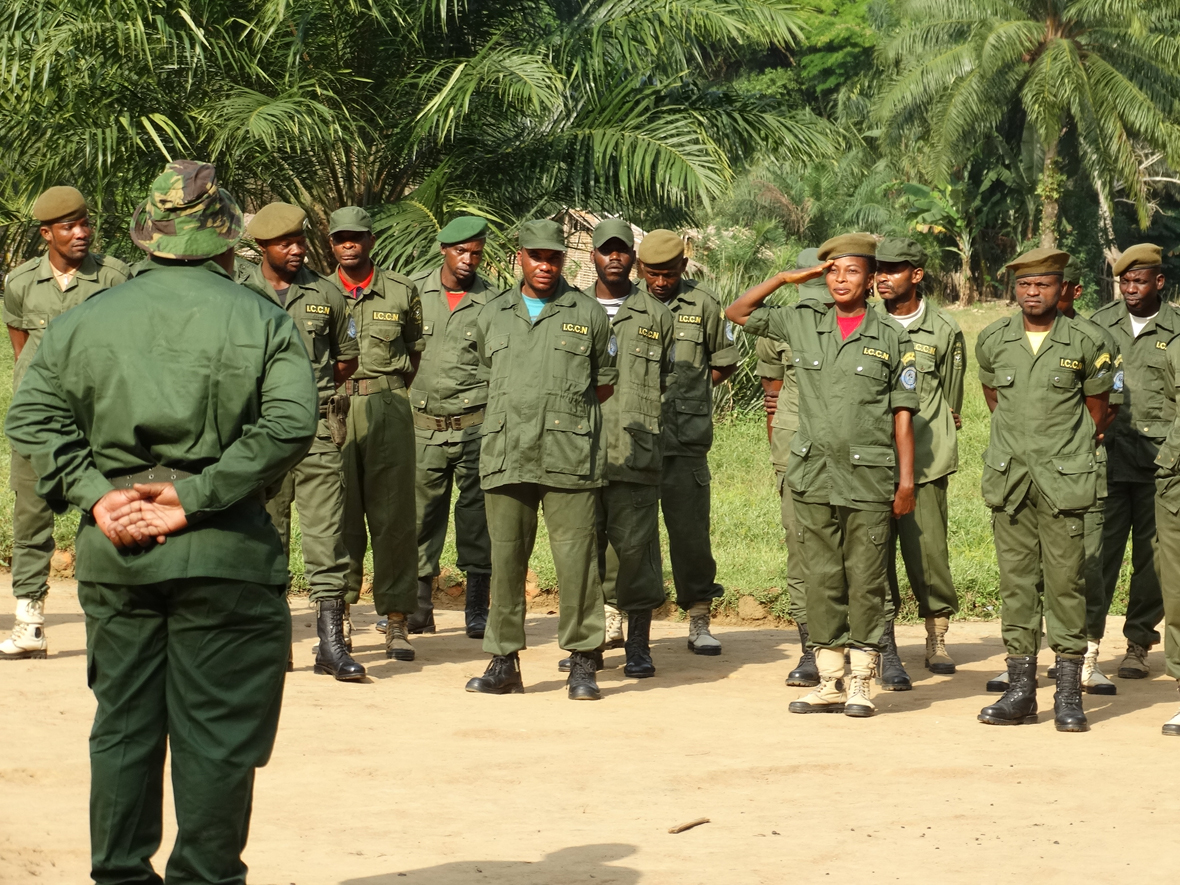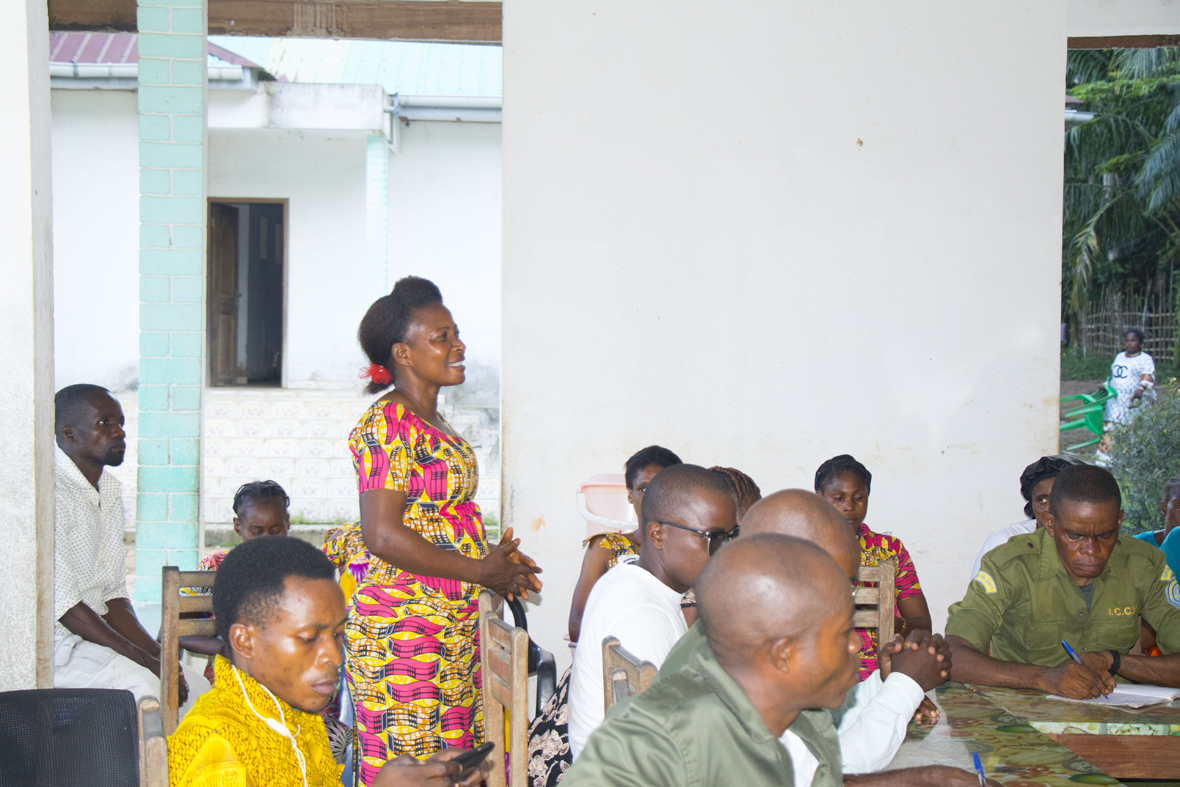Conservation Found Her at a Young Age. Now, this Eco-Guard Is Paying It Forward.

Emancie Ekofo Bafalanga during the park ranger patrol briefing. ©AWF
Many things about the Democratic Republic of Congo linger in the memory of anyone who has encountered it. The people, the culture, and the biodiversity all come together to ensure an unforgettable experience.
First memories of a country she calls home are in her mind.
"At the age of 9, when I was finally able to read, I asked my father why the picture on the wall of our living room said 'connaitre et protéger les richesses du Zaïre'," says Emancie with a nostalgic smile as she recalls the first time she heard the word "conservation."
Now 44, these memories from decades ago define her love affair with the nation she calls home and, more specifically, an ecosystem she would give her all to protect: the Lomako Yokokala Wildlife Reserve.
The Lomako Yokokala Wildlife Reserve is a protected area in the north of the Democratic Republic of the Congo, spread across Bongandanga and Befale, in the provinces of Mongala and Tshuapa. It covers an area of 3,625 square kilometers. To its north is the Yokokala River, and to its south is the Lomako River.
Established in 2006 with the support of the African Wildlife Foundation (AWF) and the Institut Congolais pour la Conservation de la Nature (ICCN), the reserve is best known for being home to iconic species such as the bonobo, forest elephant, Congolese peacock, and bongo antelope. It plays a crucial role in conserving biodiversity and protecting forest ecosystems.

Emancie at the command post, surrounded by her fellow eco-guards during a parade in Lingunda, Lomako. ©AWF
When a Youth Encountered Conservation, a Future Leader Was Born
Since its establishment, AWF has continued to provide technical and financial support to the ICCN, particularly in the fight against poaching. The development of income-generating activities, such as alternatives to hunting and the sensitization of local communities and administrative units, encourages an all-inclusive approach to the reserve's management.
"My father wasn't an environmentalist," she says, tracing her journey into conservation and linking it to that picture on her living room wall all those years ago.
"But that evening, he explained the importance of protecting flora and fauna and assured me that if their generation hadn't done so, my brothers and I wouldn't have known or found certain species."
This was her introduction to conservation.
"And since then, I have become attached to nature," she adds.
The eldest in a family of nine, Emancie, at 26, decided to become an eco-guard, much to the surprise of her mother, who had other plans for her eldest child. If everything went according to plan, Emancie would become a farmer, spending her days on the family farm.
Her passion, however, shone through, leading her to a predestined path. At a very young age, she joined the reserve's eco-guards, eager to contribute to the conservation of wildlife and natural habitats.
Her commitment transcended work. During the holidays, she took every opportunity to share the values of environmental conservation with her siblings. Sowing these seeds of awareness within her own family was the first step toward leadership.
An Enduring Conservation Legacy
Just as she was finding her footing as an eco-guard, tragedy struck. Her father, who introduced her to the conservation world, died. The news nearly broke her heart into a thousand pieces.
"Even in his death, he still taught me," she says.
African funerals, though sad, are also occasions to celebrate life. Often, men go into the forest to hunt for food that will be used to feed visiting mourners. This time, though, it was different.
Concerned about this sad truth, she raised awareness among her brothers and spoke against poaching. As an eco-guard involved in patrols, she knew the poaching hotspots and curated awareness campaigns to discourage the community from poaching.
"I told them that if wildlife disappears, so too will they," Emancie says.
These conversations showed her a need for further engagement and to move this message to younger audiences.
Reaching Today’s Youth with a Conservation Message
Although she works as an eco-guard within the Lomako Yokokala Wildlife Reserve and is the head of the Bonobo Protector Mothers Association, she also serves as an Advisor to AWF, incorporating conservation learning into the day-to-day activities of the children of Ilima Primary School.

Group photo of Bonobo Women Association members. ©AWF
Her younger brother, Divin Nemo, has also taken after his elder sister.
"I've dedicated myself to passing on the knowledge I've gained from her to my children so that when they grow up, they will choose to make the right choices," Divin says.
Love and Conservation Bring Us Together
Emancie's journey in life has brought her joy and love. Her husband, Albert Ifasso, is also an eco-guard.
"I think she made the best choice of all," Emancie's friend Ngole Jacqueline says of Emancie's marriage.
But her influence doesn't stop there. She is now the president of the Women's Conservation Association. In this role, she rallies, motivates, and sensitizes women to become agents of change in their communities.

Emancie speaking as president of the Association of Women Protectors of Bonobos during a workshop presenting their activities to the management committee of the Lomako Yokokala Wildlife Reserve. ©AWF
"Her influence is touching and changing lives," says Albert.
Her current role is supervising 53 women between 25 and 35.
"She brought us together to form this association to help women create income-generating activities to cushion them against food shortages in the reserve," says Bokamba Monique, the association's Vice-President.
Today, the association makes significant contributions to anti-poaching initiatives.
"We hope to recruit more women in the coming days," says Gérard Bofeko, Lomako Yokokala Wildlife Reserve Site Manager. "She reminds us that every gesture counts and that leadership begins with vision and unwavering determination."
When conservation reaches someone at a young age, they can create new opportunities and interest throughout the rest of their lifetime. Read other stories about this “multiplier effect” in the latest issue of Resilient Africa.